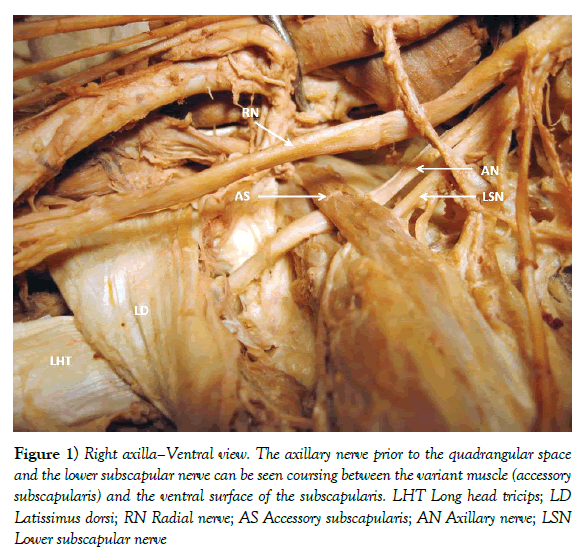Bilateral presence of a variant subscapularis muscle
Received: 03-Oct-2017 Accepted Date: Nov 02, 2017; Published: 10-Nov-2017
Citation: Krause DA, Youdas JW. Bilateral presence of a variant subscapularis muscle. Int J Anat Var. 2017;10(4):79-80.
This open-access article is distributed under the terms of the Creative Commons Attribution Non-Commercial License (CC BY-NC) (http://creativecommons.org/licenses/by-nc/4.0/), which permits reuse, distribution and reproduction of the article, provided that the original work is properly cited and the reuse is restricted to noncommercial purposes. For commercial reuse, contact reprints@pulsus.com
Abstract
We describe the presence of an accessory subscapularis muscle observed bilaterally in a human anatomy laboratory. The muscle originated from the mid-region of the lateral subscapularis inserting into the proximal humerus with the tendon of the subscapularis. The axillary and lower subscapular nerves coursed between the observed muscle and the subscapularis. The presence of the muscle has potential to entrap the axillary nerve and the lower subscapular nerve.
Keywords
Accessory subscapularis; Axillary nerve; Lower subscapular nerve; Entrapment
Introduction
Several anatomic variations in axillary musculature have been reported [1- 4]. One of the more common variations is the axillary arch muscle, also known as Langer’s muscle, the axillopectoral muscle, and the pectordorsal muscle [3,4]. This muscle typically arises from the lateral aspect of the latissimus dorsi inserting deep to the pectoralis major on the humerus. Several variations of the axillary arch muscle are described with a reported incidence of 6-9% [4-6]. Less frequent and distinctly different than the axillary arch muscle, is a variant muscle associated with the subscapularis. This has been termed the subscapulo-humeral muscle, subscapularis minor, subscapularis-teres-latissimus muscle, and the accessory subcapularis muscle [1,2,7]. Reported incidence ranges from 0.45 to 2.6% [2,7].
Case Report
A variant muscle associated with the subscapularis bilaterally was observed on a Caucasian female embalmed cadaver during routine dissection in a human anatomy class for first year physical therapy students. The variant muscle was observed on the ventral surface of the subscapularis muscle. The variant muscle appeared to be associated with the subscapularis. The muscle originated from the mid-region of the lateral subscapularis inserting into the proximal humerus with the tendon of the subscapularis. Innervation was via the lower subscapular nerve. On the right side (Figure 1), the muscle was approximately 1.5 cm in width and 7 cm in length. On the left side, the muscle was 1 cm in width and 7 cm in length. Both axillary and lower subscapular nerves passed between the variant muscle and the subscapularis proper. This relationship of nerve course to the variant muscle was observed bilaterally. The presence of the muscle represents an anatomic site at which the axillary nerve and the lower subscapular nerve could be susceptible to entrapment.
Figure 1) Right axilla–Ventral view. The axillary nerve prior to the quadrangular space and the lower subscapular nerve can be seen coursing between the variant muscle (accessory subscapularis) and the ventral surface of the subscapularis. LHT Long head tricips; LD Latissimus dorsi; RN Radial nerve; AS Accessory subscapularis; AN Axillary nerve; LSN Lower subscapular nerve
Discussion and Conclusion
The clinical relevance of variant axillary muscles includes the potential for vascular, sensory, and motor compromise. The axillary arch muscle has the potential to compress neurovascular structures in positions of shoulder abduction and external rotation producing symptoms similar to thoracic outlet [6,8]. Quadrangular space syndrome is compression of the axillary nerve and posterior humeral circumflex artery which may be secondary to paralabral cysts or fibrous bands [9]. Possible symptoms include weakness and atrophy of the deltoid and teres minor, paresthesias in the lateral shoulder, and dull aching in the posterior shoulder. In our case, and of possible clinical importance, is the relationship of the muscle to the course of the axillary and lower subscapular nerves. We hypothesize the accessory subscapularis with the relationship we observed has the potential to entrap the axillary and lower subscapular nerve medial to the quadrangular space proper producing axillary nerve sensory symptoms and possible motor deficits of the deltoid, teres minor, and teres major. The accessory subscapularis is a rare occurring variant muscle. Clinical awareness of this and other muscular variations in the axillary region should be considered in the differential diagnosis when examining patients with shoulder symptoms.
REFERENCES
- Breisch EA. A rare human variation: the relationship of the axillary and inferior subscapular nerves to an accessory subscapularis muscle. Anat Rec. 1986;216:440-2.
- Kameda Y. An anomalous muscle (accessory subscapularis-teres-latissimus muscle) in the axilla penetrating the brachial plexus in man. Acta Anat. 1976;96:513-33.
- Pillay M, Jacob SM. Bilateral presence of axillary arch muscle passing through the posterior cord of the brachial plexus. Int J Morphol. 2009;27:1047-50.
- Mérida VJR, Rodríguez VJF, Mérida VJA, et al. Axillary arch: potential cause of neurovascular compression syndrome. Clin Anat. 2003;16:514-9.
- Rizk E, Harbaugh K. The muscular axillary arch: an anatomic study and clinical considerations. Neurosurg. 2008;63:316-9.
- Clarys JP, Barbaix E, Van RH, et al. The muscular arch of the axilla revisited: its possible role in the thoracic outlet and shoulder instability syndromes. Man Ther. 1996;1:133-9.
- Yoshinaga K, Kawai K, Tanii I, et al. Nerve fiber analysis on the so-called accessory subscapularis muscle and its morphological significance. Anat Sci Int. 2008;83:55-9.
- Hafner F, Seinost G, Gary T, et al. Axillary vein compression by Langer’s axillary arch, an aberrant muscle bundle of the latissimus dorsi. Cardiovasc Pathol. 19:e89-90.
- McClelland D, Paxinos A. The anatomy of the quadrilateral space with reference to quadrilateral space syndrome. J Shoulder Elbow Surg. 2008;17:162-4.







